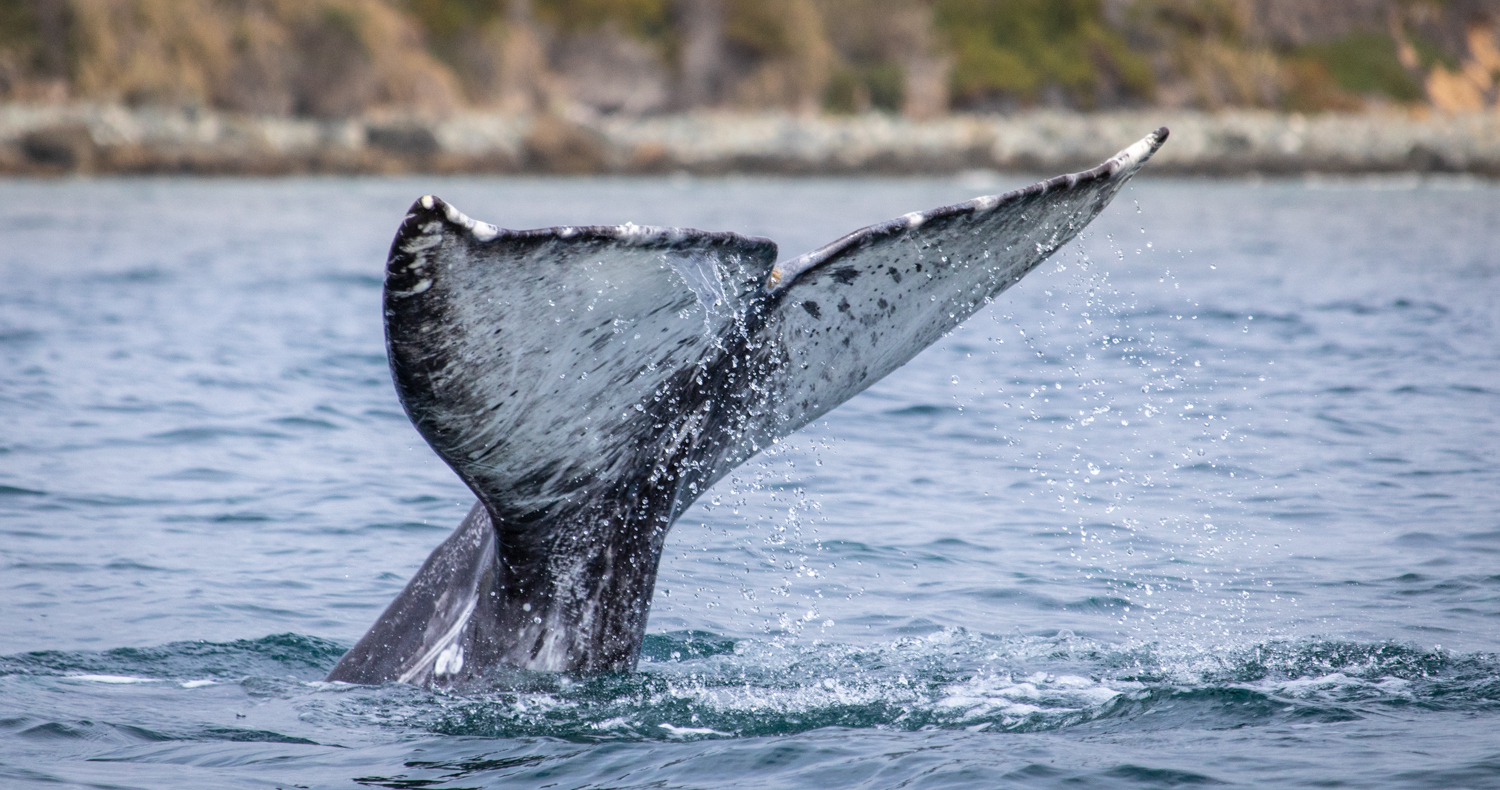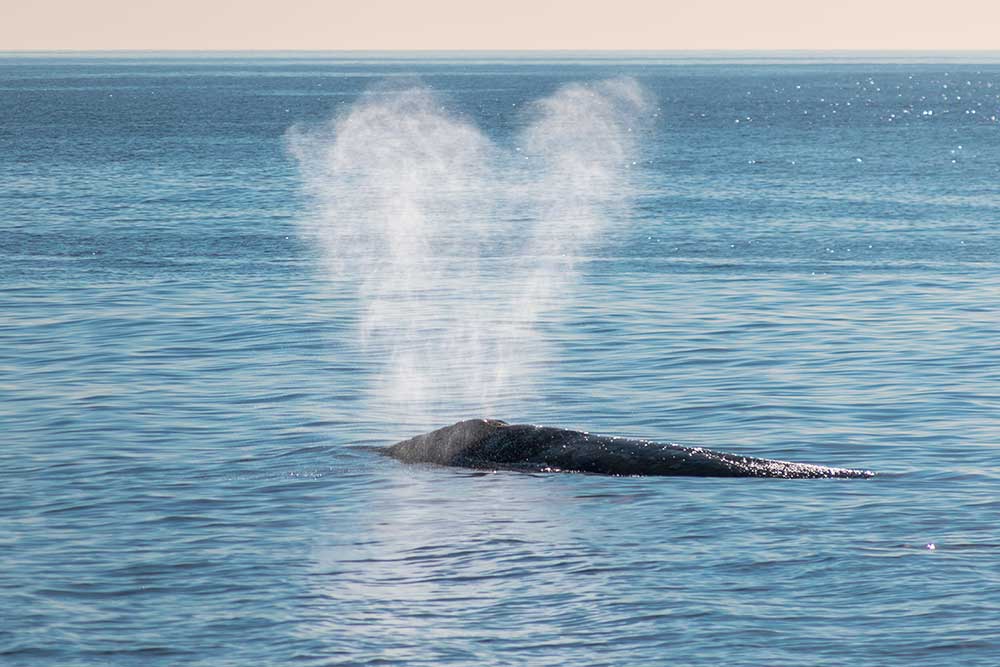10 Things That Are Amazing About Gray Whales

Gray whales (Eschrichtius robustus), are known as the California gray whale because these whales travel down our stunning California coastline every year on their way to the lagoons of Mexico each winter. Their annual trip down our coastline may be our favorite part of this whale’s migration and one of several highlights of some pretty cool gray whale facts we can’t wait to share with you! Read below to learn about our top 10 amazing gray whale facts that are sure to capture your interest and will leave you excited to book your Dana Point whale watching trip today!
1. The gray whale is the only living member of the baleen whale family Eschrichtiidae
That is right; there is only one member of the genus Eschrichtius robustus and this is due to how these whales feed. While gray whales have the presence of two blowholes and baleen instead of teeth like all other rorqual whales gray whales are in a class of their own when it comes to how they forge for their daily feasts, making them the most similar to the likes of a rorqual whale but falling just outside this genus.
2. Gray whales look like no other whale!
Of course, all whales look different, but some have more similarities to other whales than others. There is no mistaking a gray whale in the water. If you think you see a massive floating rock, you unmistakably have sighted a beautiful gray whale. Unlike rorqual whales, the gray whale lacks a distinct dorsal fin. Instead, they have a dorsal “hump” and a series of six to twelve “knuckles” or nodules that look like a bumpy ridge about two-thirds of the way down their muscular back. Also, unlike most whales, the gray whale has paddle-shaped flippers, which help them nestle into the mud and suck in the sediment from the bottom. Although their overall size is large, the head of a gray whale is relatively small and narrow compared to the length of their overall body size. Covered in barnacles and commonly seen with whale lice, all 45 feet of the gray whale can be covered entirely in these hitchhikers. Other key characteristics include the scars left behind by parasites that drop off in its cold feeding grounds. Sometimes gray whales are curious and playful and will take a moment to swim up and check out passengers too. Our eye-to-eye underwater viewing pods aboard our flagship vessel Manute’a could give you an up-close and personal introduction that we can promise you will never forget!
3. Gray whales have vast migrations!
Ever sit and think, “man, my commute sure is long!” One of the most interesting gray whale facts is they have the longest commute in the world. That’s right! The gray whale has massive migrations, putting these stunning creatures at the top of the list above others in the animal kingdom. As icy waters near the Chukchi and the northern Bering Sea begin to freeze in winter, the gray whale migration is triggered. Whales start to make their trek down the West Coast, never even stopping for food along the way. Now that is one heck of a trip if you ask us! Gray whale migrations can be anywhere from 5k-7k miles each way – totaling 12k-14k roundtrip. Now that is quite a distance!! Pregnant mothers are the first to arrive in the lagoons of Mexico, where they will birth their young and relax after such a long trip until they are ready to return to their feeding grounds in the Chukchi Sea and the northern Bering Sea in Alaska with their little ones. Whether on a private whale-watching safari or one of our public trips, Captain Dave’s Dolphin and Whale Watching Safari® is the best place to catch an up-close view of these beauties along their incredible journey.
4. Gray whales carry approximately 400 lbs. of hitchhikers!
“New Year, New You” doesn’t quite apply to the gray whale. Barnacles and whale lice are not strangers to these whales. Gray whales have more hitchhikers on board than any other whale in the ocean. One of the essential gray whale facts to remember is that the transport of whale lice and barnacles is considered a communal relationship and one that is incredibly vital for the success of both species. Barnacles use these docile and friendly whales to transport them from place to place and from icy waters down to the warmer waters in Mexico. The same whale lice that are a burden to carry is also helpful in healing injuries gray whales encounter throughout their lives. So, while it may be exhausting to carry around an extra 400lbs, it is also vital to their survival to have these extra companions along for the ride.
5. Gray whales are right-handed!
When it comes to gray whale facts that really stand out, how a gray whale finds its food is certainly unusual. The gray whale is considered a bottom feeder. This means their primary food source is pulled from the ocean floor. Oddly enough, studies show that these beautiful bottom feeders prefer to “swipe right” when it comes to their preference on which way they roll too. When the gray whale feeds, they turn their incredibly large bodies exactly 90º to the right (most common) or left to nestle their baleen into the ocean subfloor. Then, the gray whale will begin to suck from the muddy floor to pull out their favorite amphipod crustaceans on the menu. Amphipods are tiny shrimp-like animals living within sediment on the ocean floor. Scientists have been able to determine which side they prefer to roll to by looking at the sides of their rostrum or snout and the baleen inside to see which side has more wear and tear from scraping sediment from the ocean floor.
Like us, whales like variety when it comes to mealtime so they also munch on small creatures called cumaceans and isopods, and also ingest other mud-dwelling invertebrates, including tubeworms and mollusks. If you are on one of our trips and see the upper jaw of a gray whale above the waterline, they could be skim-feeding. Typically when they do this, they have decided to devour some plankton, which are microscopic animals floating in the Sea. Regardless of what they choose to eat, the most environmentally focused gray whale facts relate to our ecosystem. Their feeding habits are impactful for our ecosystem as a whole. The gigantic mud plumes they create while eating re-suspend large volumes of nutrients, which in turn enrich life on the seafloor and bring a bounty of bottom-dwelling crustaceans to the surface for seabirds to feast on.
6. Whales do not chew their food.
More gray whale facts that are interesting to our passengers are how whales hunt and consume their prey. Known for their massively large size, these next gray whale facts may blow your mind. Rorqual whales make up some of the largest animals on our planet, but their primary meal source is derived from some of the smallest creatures. Rorqual whales have the presence of baleen, a keratin-like set of plates that line their mouths instead of teeth. These baleen plates act like a sieve to filter food from the water inside of a whale’s mouth. Just like a sieve allows water to drain from the pot, baleen plates trap a whale’s food source inside a whale’s mouth, while water can drain freely through the plates. Baleen plates range in length depending on the whale species, making these next set of gray whale facts interesting too! Did you know that inside a gray whale’s mouth, they have up to 180 baleen plates that hang down inside their jaw? Stiff and bristly, baleen plates fringe at the bottom and are about 18” in length.
7. Their surface trademark is a heart-shaped blow.
With two separate blowholes, when a gray whale surfaces for air and lets out a massive exhale, their trademark is the heart-shaped blow it leaves behind for us to see. Having a winter migration is extra special as we approach February, and hearts adorn the walls and shelves of every store in town. Especially sweet is seeing more than one heart shape fill the air above the surface at the same when multiple gray whales are traveling together. A passenger’s all-time favorite is when the heart shape they spot is tiny, and a glimpse of a baby born along the migration route is accompanying mama down to the warm birthing lagoons of Baja.

8. The gray whale is one of the only animals to come off the endangered species list.
Today, gray whales are a conservation success story but this was not always the case in this whale’s history. By 1950, nearly all gray whale populations were completely decimated. Above, we read the gray whale travels great distances to give birth to its young. We also learned they feed on the bottom of the ocean floor. Both of these behaviors combined are what led these majestic animals to their ultimate demise. Easily sighted and therefore easy targets for hunters to prey upon made for the best conditions for whale hunting. The mid-1800s and again in the early 1900s mean Eastern Pacific gray whales were hunted to near extinction. Hunted for their blubber, used to produce an oil used for lamps, the gray whale was easily accessible to whalers because they remained close to the coastline. They became overhunted in Southern California and Mexico, and as populations rebounded in the 1920s, whalers used “floating factories” to process the whales out at sea. This horrendous and hideous practice came to a halt in 1946 as the IWC or International Whaling Commission was created. After the Marine Mammal Protection Act was set in October of 1972, the gray whale species began to make an astounding comeback. Today they are protected within the International Whaling Commission (IWC), under the Marine Mammal Protection Act (MMPA), the Endangered Species Act (ESA), and the Convention in International Trade of Endangered Species (CITES).
There were once three stocks of gray whales:
- Atlantic Ocean, which is now long-extinct
- Western Pacific
- Eastern Pacific
Today there are roughly over 27,000 Northern Pacific Stock, which keeps them clear off today’s endangered species list. Sadly, The Western Pacific stock or DPS remains very low in number totaling only 200+ individuals and, according to the ESA, is still endangered and considered depleted under the MMPA.
9. The gray whale was also called the “devil fish”.
If you were being hunted by fishermen throwing harpoons at you and your family, you would be mad too! Being an animal spending much of its time in shallow waters, the gray whale created the perfect storm for fishermen to use harpoons as their main form of hunting tactic against the defenseless gray whale. Pregnant mothers and young newborn calves were brutally hunted and attacked in the lagoons of Mexico, where mothers would arrive to have their young after a tireless and food-scare journey of over 6k miles. Harpooned for their blubber used to create oil for lamps, these animals began to fight back once under attack and, through the process, earned themselves the name “devil fish” by their human predators.
Astonishingly, gray whales have found peace in their hearts towards humankind. Years of anger towards humans for such barbaric treatment of their species existed, and since the many protection acts put into place, the gray whale species have rebounded. Today, it is possible to visit the lagoons of Mexico and see gray whale mothers with their young, and whale culture has taught them that man is no longer a threat with a harpoon in their breeding grounds. They often swim right up to boats and poke their heads vertically out of the water to get a better view of their surroundings in a behavior called spy-hopping.
Amazingly, this species has taught us the divine lesson on what it means to forgive and forget.
10. Gray whales are the most commonly studied whale!
Gray whales are the most studied, as they are the easiest to spot and observe from the surface because so much of their time is spent near the coastline and the gray whale migration pattern is predictable. Researchers, scientists, and volunteers alike can easily study these animals both from land and water perspectives and healthy populations make this easy. Since these gorgeous creatures hug our coastline, researchers are able to identify them in a variety of ways. And, since some gray whales spend their entire lives off the Oregon coast, there are plenty of case studies to choose from when studying these animals’ behaviors!
Until next time,
Jess Wright
First Mate and Marine Naturalist
Capt. Dave’s Dolphin & Whale Watching Safari
